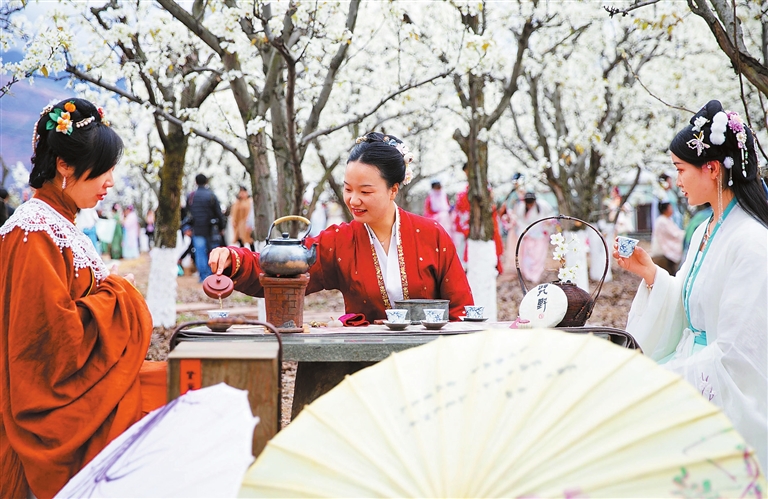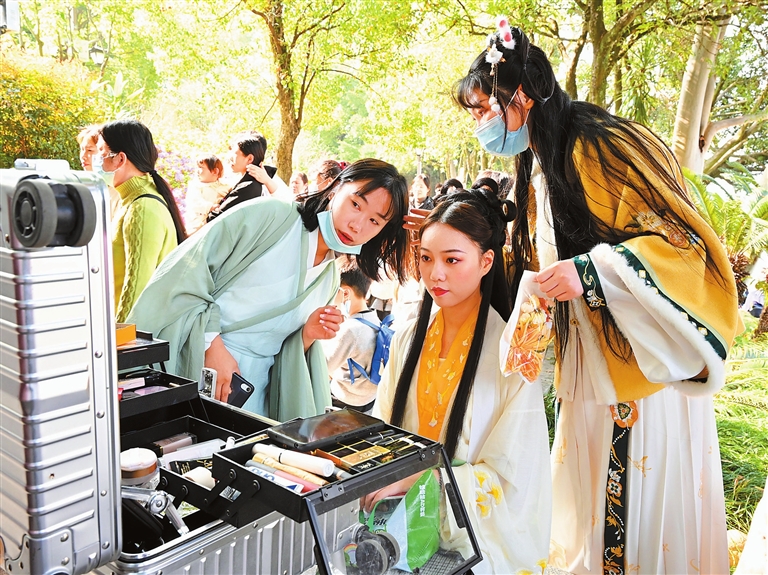

Zee Wong zedwong126@126.com IF you see people wearing big robes with big sleeves in the subway, don’t be surprised. They are just a part of the growing population of tongpaos, or Han clothing enthusiasts. Driven mainly by popular costume dramas, the fan base of traditional Han clothing (hanfu) became larger and younger, increasing 11 times from 320,000 in 2014 to 3.56 million in 2019, with 80 percent of them under 24 years old, according to a research led by XKB Data Research Center. Last week, the hanfu circle got all psyched up by a proposal during the National People’s Congress (NPC) and the Chinese People’s Political Consultative Conference. Cheng Xinxiang, deputy to the NPC and an inheritor of Hunan embroidery intangible cultural heritage, suggested making the third day of the third lunar month the national Hanfu Day. A poll launched by Xinhua News on Bilibili.com surveyed the netizens’ opinions about the proposal. Among the 14,800 participants, 68.59 percent voted yes and 25.21 percent voted no. “The significance of this festival lies in the promotion of hanfu. It is quite a pity that people walking on the street dressed in hanfu are deemed outlandish by many,” said Amy, a 20-something tongpao. Compared to the prevalence of other Asian traditional attires, such as the Japanese kimono and Indian saree, in their home countries, hanfu is yet to become accepted in China. The incident that occurred during last month’s Lantern Festival is a good example. A young couple in Wuxi, Jiangsu Province, attempted to get their marriage registered using a photo of them dressed in hanfu, but was rejected by the staff at the registry, giving them the reason that the regulation is ambiguous when it comes to hanfu. Therefore, using a hanfu photo for marriage registration depends entirely on the staff’s judgment. In an interview by Sina news, the marriage registry staff in Xi’an, Wuhan, and Zhengzhou said couples are allowed to use hanfu photos for registration. The topic “Marriage registry staff rejected registration using hanfu photo” has been widely discussed on social media and with different views. KOL Geng Xiangshun said, “Japanese regard the kimono and Korean hanbok as formal attire for ceremonies. When it comes to important occasions in life, they are prone to wearing such traditional clothes. Hanfu photos should be accepted for marriage registration.” And for those who opposed the use of hanfu photo, some stated that the lack of a formal standard in defining hanfu causes great confusion. Admittedly, despite the growing passion and rising awareness in the preservation of traditional culture reflected through hanfu, relevant knowledge and understanding is still lacking. The top comments underneath the Xinhua poll expressed an eagerness for professionals to promote the knowledge of hanfu. The comment “Don’t just set up a festival, the diffusion of knowledge needs to catch up,” received more than 2,100 likes. Other top comments took into consideration that China is composed of 56 ethnic groups, and advised an alternative name, national Huafu Day, playing on a phrase — huafu — that means both Chinese clothing and fine clothes. In fact, the date chosen for Hanfu Day, the third day of the third lunar month, used to be the Shangsi Festival, a merry occasion when men and women dressed up for spring outings and riverside activities. The proposed national Hanfu Day seems to be an integration of two important festivals in hanfu circles, the voluntary Travel in Hanfu Day on Nov. 22 and the Chinese National Costume Day on the third day of the third lunar month that was initiated by the Central Committee of the Communist Youth League. The Travel in Hanfu Day is to commemorate the pioneering event on Nov. 22, 2003, when Wang Letian, an electrician, stepped out onto the crowded street in Zhengzhou, dressed in hanfu, against varied misunderstandings and judgement. Wang was the very first person who brought hanfu back into everyday life, ever since the system of head shaving and clothes changing was imposed centuries ago by the Manchu emperor Shunzhi. This one-man show was reported by the Singapore-based Lianhe Zaobao and received a warm response from Chinese people all over the world. The Travel in Hanfu Day is now celebrated in many countries, including Australia, Germany, Italy, Japan, Singapore, and the United States. Meanwhile, the first Chinese National Costume Day was set in 2018, aiming to revitalize traditional clothing of the Han people, which accounts for 91.6 percent of the total Chinese population, according to the latest data from the sixth national census in 2010. Unfortunately, due to the aforementioned historical reasons, hanfu has a long way to go in order to keep the same pace with the traditional attires of the other 55 ethnic groups in China in terms of recognition and preservation. The promotion of Chinese National Costume Day through the wildly popular Bilibili.com site has contributed greatly in sustaining the craze for hanfu. Eighteen years have elapsed, from Wang’s very first step in 2003 to Cheng’s proposal in 2021, as more and more people join forces in the revival of hanfu and the renaissance of Chinese culture. | 
